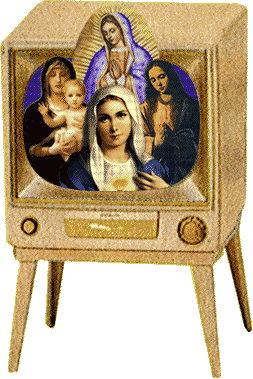
The revolution may not be televised, but the Second Coming will be. American pop culture has a hankering for the holy these days. Fear of blasphemy hasn't stopped CBS from broadcasting its maudlin series Touched By An Angel, nor did it stop Robin Williams from making the hideously stupid What Dreams May Come, a movie whose whole point seemed to be that heaven and hell look really neato on the big screen, especially if you can get an A-list actor to pose in front of them.
Modern-day miracles are an especially good audience draw. There are a few kinds of miracles that just never go out of fashion -- healings, bodily fluid-exuding religious icons, visions. These are a dime a dozen in the United States, showing up in places as unlikely as Conyers, Georgia and Emmitsberg, Maryland. But 18th century philosopher David Hume's oft-cited definition of miracles casts a much wider net. Trying to prove that miracles were a bunch of hooey in a scientific age, Hume scoffed, "A miracle is a violation of the laws of nature."
But one person's snide remark is another person's faith. Father Frank Buckley, a Jesuit living in San Francisco, echoed Hume when he defined a miracle as "a clear sign of God's intervention beyond normal human experience."
Everybody wants to be a saint, so perhaps that's why so many Americans these days are getting into the whole miracle-working biz. One of the more bizarre proto-saints is Audrey Santo, a comatose teenager living in Worcester, Massachusetts, whose mother keeps a shrine in the family garage. Pilgrims to the Santos' garage report seeing statues that drip oil, communion wafers with blood frosting, and, of course, healings that they attribute to the unconscious Audrey's blessing.
Other miracle workers tend to be more, well, wordy. Veronica Leuken, a housewife who lived in New York City's Queens borough, reported that the Virgin Mary appeared to her and gave her "messages." Veronica dutifully dictated all these messages into a tape recorder. Since Veronica's death in 1995, her followers have continued to keep vigils for her at a local shrine. Although church authorities in New York condemned her visions as inauthentic, devotees of the "Seer of Bayside" insist that Veronica's audiotapes from the Blessed Mother are the real deal.
According to Peter Williams, a professor of religion and American studies at Miami University in Ohio, most miracles are only "quasi-official" or even "doubtful" in the eyes of Catholic Church authorities. And while America has sprouted its own strange crop of miracles and shrines to them, this country has also remained true to its obsession with mass-produced junk by erecting dozens of replicas of European shrines. All of the many replicas of the famous Lourdes shrine at Notre Dame are "regarded as fully functional," said Williams. Apparently even a simulated shrine can lead to authentic miracles.
Mostly, the Catholic Church is interested in verifying miracles to determine whether the person performing them should be canonized and declared a saint (becoming a saint requires that you be responsible for at least two miracles, according to Roman Catholic doctrine). According to Buckley, "The Church never passes judgment on miracles until some time after the death of the person involved. There are so many alternative explanations possible that they like to wait until the dust settles."
Fact is, it's just plain hard to become a saint. Father Frank Parrish, a Jesuit living in Los Angeles, was one of the key parties involved in the beatification (sainting) of Claude de la Colombière, a preacher who died in 1682 (and had to wait until 1992 before Rome finally acknowledged his sainthood). Parrish, who was responsible for providing evidence for St. Claude's second miracle, made the process sound positively bureaucratic. "I had to get all the testimonies of those concerned, the doctors, and the people who were praying. I had to send X-rays to Rome. Bishop Ward, who also worked on the case, said he had a pile of depositions a foot tall."
The miracle in question had been performed in the presence of Parrish himself, who was using a relic of St. Claude -- a piece of his bones -- to bless somebody with pulmonary fibrosis. According to Parrish, the person recovered from this generally fatal disease.
Parrish's story also demonstrates that miracles can sometimes go awry in very mundane sorts of ways. While blessing a group of people in an L.A. restaurant, Parrish lost the relic that was responsible for St. Claude's second miracle. Said Parrish regretfully, "I looked all over in my friend's car, and I called the restaurant, but nobody could find it. But that's OK, because there are more relics of St. Claude and I got some more while I was in Rome." Well, that's a relief.
Most religious pundits would agree that people's hunger for miracles now is partly a response to the growing secularization of everyday life. Williams thinks it's also about seeking authority. He cited the Blue Army, a right-wing Catholic group that combines reactionary politics with a mystical belief in the miraculous. Asserted Williams, "For people like them, religion is about being plugged into another realm of being, a form of power."
Father Moses, an Eastern Orthodox monk, had another possible explanation. "There might be a demonic side to these appearances of the Virgin Mary. In the Orthodox tradition, visitations are not necessarily from God. Satan can appear as an angel of light."
With all these miracles going on, it's easy to forget about Satan. Maybe the Big Sulfurous Guy just needs his own TV show.
See Also: Probing Inside the Virgin
Annalee Newitz is a freelance writer in San Francisco, and is the author of a forthcoming book on movies about monsters, psychopaths, and the American economy.
